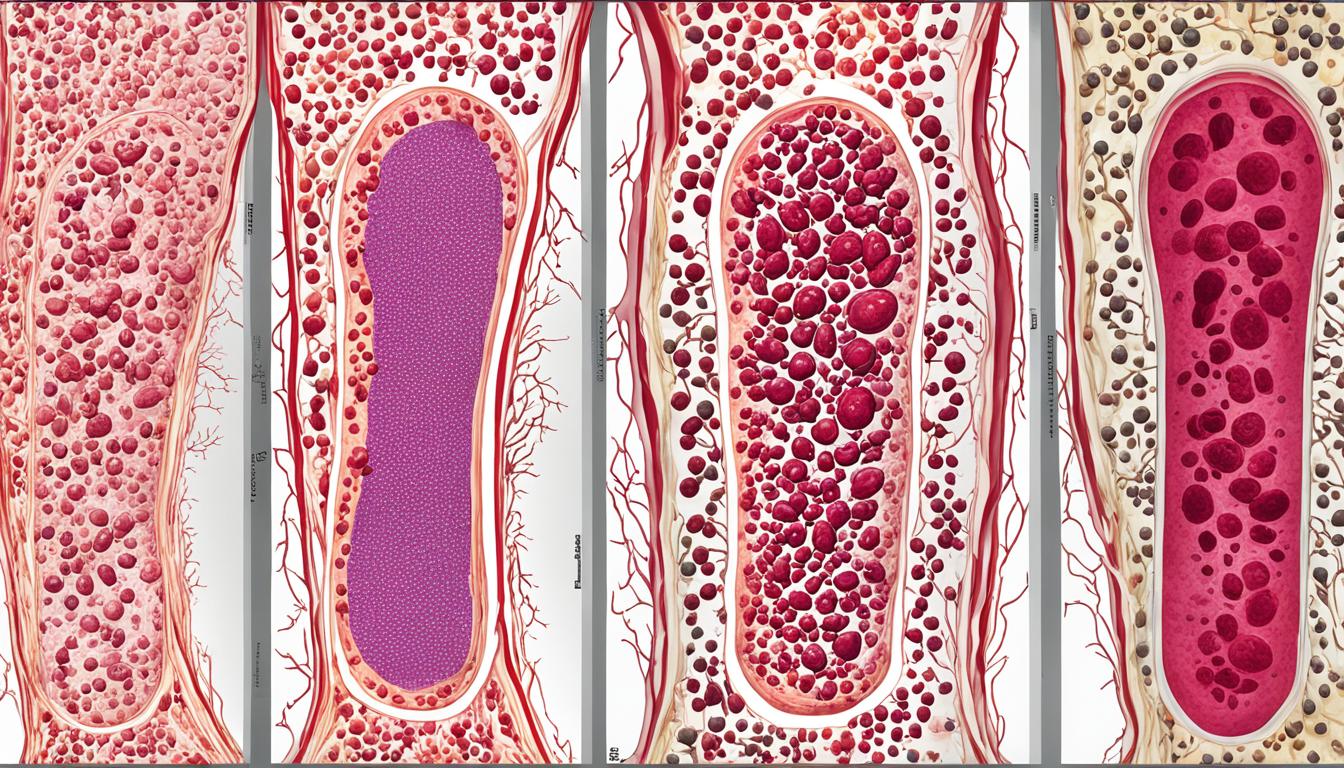Anal cancer happens when cells in the anal canal grow out of control. This leads to the formation of tumors. It’s different from colorectal cancer in many ways. The anal canal is at the end of the digestive tract, near the rectum. It’s made up of various cells that can turn cancerous. The main type is squamous cell carcinoma.
Several things make you more likely to get anal cancer. These include HPV infection, getting older (between 50 and 80), and smoking. Other risks are frequent anal problems, like irritations and fistulas. People with weak immune systems, due to HIV or certain medicines, are also at a higher risk.
The signs of anal cancer at first might not seem serious. They can include bleeding, pain, or a lump near the anus. You might notice changes in your poop or feel sick after eating. Doctors check different things to see how advanced the cancer is. They look at the tumor size and if it has spread to other parts of the body.
To fight anal cancer, doctors have a few treatments. They may do surgery, radiation, or give you chemotherapy. The best option depends on the cancer type and your overall health. Lately, scientists are excited about the potential of using stem cell therapy. It could be a new, effective way to treat anal cancer. But there’s still much to learn about how well and safely it works.
Key Takeaways:
- Anal cancer is characterized by the uncontrolled growth of cells in the anal canal.
- The causes, risk factors, symptoms, and treatment options for anal cancer differ from those of colorectal cancer.
- Risk factors for anal cancer include HPV infection, age, anal irritations, anal fistula, and smoking.
- Early symptoms of anal cancer can include bleeding, pain, swelling, discharge, and changes in stool patterns.
- Treatment options include surgery, radiation therapy, and chemotherapy, with emerging interest in stem cell therapy.
Anal Cancer Symptoms, Diagnosis, and Prevention
It’s vital to know the early signs of anal cancer for prompt medical help. These signs can seem vague. But understanding them is key to catching the disease early. Symptoms often include:
- Bleeding from the anus: Blood in the stool or on toilet paper can be a sign.
- Pain in the anal canal: Feeling discomfort or sharp pain in that area may signal an issue.
- Discharge from the anal canal: Look out for pus-like discharge or mucus.
- Mass or swelling around the anal opening: A visible lump or growth close to the anus should not be ignored.
- Digestive disorders: Symptoms may involve a change in bowel habits, constipation, or diarrhea.
- Changes in stool patterns: Be concerned if stools become thin or pencil-like.
Remember, these symptoms might indicate other non-cancerous conditions too, like hemorrhoids or anal warts. If you experience any, it’s important to see a doctor for a check-up. This ensures you get the right treatment. Tests for anal cancer include:
- Manual anorectal examination: A doctor might do a physical check to look for any issues.
- Analoscopy: This involves using a small, lit scope to see inside the anus.
- Biopsy: Tissue is taken from the anus and tested to confirm cancer.
- Imaging tests: Ultrasounds, CT scans, or MRIs show a clearer picture of the cancer, its stage, and spread.
- PET/CT scan: This test is used to look for cancer beyond the anal area.
While there’s no sure way to prevent anal cancer, there are steps to lower your risk. These steps include:
- Get the HPV vaccination: This vaccine helps reduce your risk by protecting against HPV.
- Practice safe sex: Using condoms can help keep you safe from HPV.
- Limit multiple sexual partners: Having fewer partners can decrease your risk of getting HPV.
- Quit smoking: Stop smoking to lower your chances of not just anal cancer, but also many other cancers.
Resources for Anal Cancer
When you’re diagnosed with anal cancer, finding reliable support and information is crucial. Here are some trusted resources for help:
| Organization | Description |
|---|---|
| American Cancer Society | They provide detailed information on cancer, including anal cancer. They also offer help with symptoms, diagnosis, and support. |
| Anal Cancer Foundation | This nonprofit is committed to increasing awareness on anal cancer. They also support patients and families in need. |
| Cancer Research UK | They are a known source for cancer information. They provide guidance on symptoms, diagnosis, and treatment options for anal cancer. |
| National Cancer Institute | This government agency offers a lot of cancer research and support. They provide info on treatment, trials, and patient support. |
These resources are there to offer information, support, and further help for those dealing with anal cancer. They help navigate your cancer journey with more confidence.
Anal Cancer Treatment and Stem Cell Therapy
Treatment for anal cancer may use surgery, radiation, and chemo. For early stages, surgery can remove the tumor and surrounding tissues. In worse cases, chemo and radiation might be used together. Radiation is given five days a week, over 5-6 weeks. Chemotherapy includes drugs like fluorouracil (5-FU) with Mitomycin C or Cisplatin. For HIV patients, lower chemo doses might be needed, depending on their immune system.
Patient support and resources are key to fighting anal cancer. These include counseling, support groups, and educational info. There are also online communities where people can find others going through the same challenges. These support systems offer help, hope, and the advice needed during treatment.
Recently, stem cell therapy has become a new area of interest in anal cancer treatment. Stem cells can become different cell types and help repair damaged tissues. Although still under research, this therapy might offer new ways to heal. Studies continue to show the true benefits and risks of using stem cell therapy for anal cancer.

